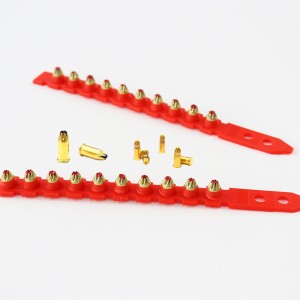A nail gun is a tool that utilizes the gas generated from firing powder loads as power to drive pins into building structures. The blank cartridges used for firing nails differ from standard military nail cartridges only in size and can similarly cause harm to humans.
The nailer is a tool that employs nail fastening technology. Compared to traditional methods such as embedded fixation, drilling and pouring, bolt connections, and welding, nail fastening offers numerous advantages: it is self-powered, eliminating the need for electricity or pneumatic sources, making it convenient for on-site and elevated work. It significantly reduces labor intensity and can even address some construction challenges that were previously difficult to solve. It also saves costs and lowers construction expenses.
1. Classification of Nail Guns
The nails fired by a powder actuated tool can be directly driven into substrates such as steel, concrete, brick masonry, or rocks without requiring external power sources like electricity or air pipes. This is because the nail cartridges themselves contain explosives that generate propulsive force, ejecting the steel nails to securely fasten components such as doors, windows, insulation panels, soundproofing layers, decorations, pipes, steel components, and wood products to the substrate. Based on their operating principles, nail guns can be divided into two main categories: direct-acting nail guns and indirect-acting nail guns.
(1) Direct-Acting Nail Guns
Direct-acting nail guns operate by having the gunpowder gas act directly on the nail, propelling it into motion. As a result, the nail leaves the barrel at a very high velocity (approximately 500 m/s) with significant kinetic energy.
(2) Indirect-Acting Nail Guns
In indirect-acting nail guns, the gunpowder gas does not act directly on the nail but instead acts on a piston inside the nail gun. The energy is transmitted from the piston to the nail. Consequently, the nail exits the barrel at a slower speed. There is a significant difference in the velocity of nails fired by direct-acting and indirect-acting nail guns.
For indirect-acting nail guns, the energy from firing the nail cartridge is divided into two parts: the energy of the nail and the energy of the piston rod. The piston rod accounts for the majority of the energy. The piston rod moves within the nail barrel, with its direction controlled by the operator through the nail gun. When the nail contacts the substrate and encounters resistance, its velocity decreases, and the energy is transferred from the piston to the nail, achieving fixation. If the nail cartridge is too powerful or the energy is excessive, causing the nail to penetrate too deeply, the piston rod will be stopped by the nail barrel and the retaining ring. The nail and piston will cease movement, with any excess energy dissipated by the nail gun.
The differences in principle and structure between direct-acting and indirect-acting nail guns result in varying performance in application. Direct-acting nail guns may offer poorer fixation reliability in certain situations and could damage the substrate structure. In severe cases, they may even cause personal safety accidents. Therefore, indirect-acting nail guns are generally preferred, as their reliability and safety are significantly superior to direct-acting nail guns.
In terms of application, nail guns can be categorized into specialized nail guns and general-purpose nail guns. Specialized nail guns are suitable for specific fields, such as repairing ingot molds in the metallurgical industry, fixing insulation panels, and hanging signs. General-purpose nail guns, on the other hand, are applicable across various industries, meeting the fastening needs of different fields.
Post time: Oct-28-2025













